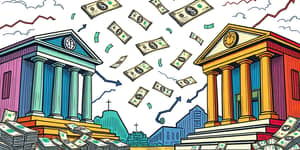
In a world where investment risk looms large, credit default swaps provide a vital guardrail for bondholders. This article explores how CDS function, their evolution, and the practical steps investors can take to leverage this powerful financial tool to protect portfolios.
Credit default swaps, or CDS, are financial instruments that mimic insurance policies for debt securities. At their core, they allow investors holding bonds or loans to offset or transfer credit risk to another party. The buyer of a CDS pays a fixed fee to the seller in exchange for a promise of compensation should the underlying bond issuer experience a credit event such as bankruptcy, missed payment, or restructuring.
This mechanism transforms the uncertain realm of bond defaults into a manageable risk, enabling investors to pursue returns with greater confidence. By treating credit default swaps as a form of insurance, market participants can hedge potential losses and stabilize long-term investment strategies.
The idea of CDS emerged in the 1990s as the market for structured finance grew. Over time, these derivatives evolved from bespoke agreements to standardized contracts traded on central platforms. Their flexibility allowed for rapid expansion but also introduced complexities for regulators and participants. Understanding this evolution helps investors appreciate both the benefits and pitfalls of credit default swaps in today's markets.
A standard CDS contract involves three main components: the protection buyer, the protection seller, and the reference entity. Each term within the agreement is carefully structured to define relationships, timing, and obligations.
In practice, if the reference entity defaults, the seller is obligated to compensate the buyer for losses either by repurchasing the bond at par value or paying the difference between par and post-default market price. This arrangement creates a clear path for investors to offset potential credit losses with a predictable cost.
CDS spreads are quoted in basis points per year of notional. For example, a spread of 200 basis points means an annual premium of 2% of the notional amount. Spreads widen when the market perceives higher default risk and tighten during periods of credit improvement. Active trading of CDS spreads provides real-time insight into changing risk perceptions, often ahead of bond market movements.
Settlement in a CDS contract can take one of two forms: physical delivery of defaulted bonds or cash settlement. In physical settlement, the protection buyer transfers the defaulted bonds to the seller, receiving their face value in return. Cash settlement relies on a market auction process that determines the recovery rate of distressed debt.
During a cash settlement, an auction establishes a market-determined price for the defaulted debt. The seller pays the surrendering buyer the difference between the bond's par value and its recovery value. Both mechanisms serve the purpose of quantifying losses and transferring them efficiently, though institutional preferences and market conditions can influence the choice of settlement method.
Institutional players often negotiate “cheapest-to-deliver” criteria to optimize physical settlement costs, selecting which bonds to deliver based on price and recovery expectations. This adds another layer of strategy, allowing keen investors to capitalize on relative value opportunities within the same issuer’s debt structure.
Consider an investor holding a $100 million corporate bond paying 8% annually. To protect against default, they purchase CDS protection at a 1% annual premium. Over a year, the investor pays $1 million in premiums. If no default occurs, those payments represent the cost of maintaining insurance-like protection. Should the bond issuer default, the protection seller reimburses the full $100 million face value, offsetting the investor’s losses.
This example highlights the trade-off between premium cost and risk mitigation. While the buyer incurs an ongoing expense, the security of knowing that default risk is capped can justify the investment, especially during economic uncertainty.
Seasoned investors monitor CDS spreads alongside other indicators, such as bond yields and credit ratings, to gauge market sentiment. By integrating CDS metrics into a broader analysis, they can anticipate shifts in credit conditions and adjust portfolio exposures before major price movements occur.
The credit default swap market has experienced dramatic growth and transformation. Notional outstanding peaked at over $67 trillion at the end of 2007. Post-2008 reforms and compression initiatives reduced this to around $7.8 trillion by mid-2019. As of June 2022, the market rebounded to $9.3 trillion in notional outstanding.
Regulatory reforms after the financial crisis led to significant market changes. Today, more than 82% of CDS trades occur on swap execution facilities, and 83% are centrally cleared through central counterparties. These measures have increased transparency and reduced counterparty risk, reshaping how CDS operate in the global financial ecosystem.
The post-crisis landscape also saw the introduction of standardized contract definitions and fixed coupons, streamlining previously bespoke agreements. These reforms enabled more efficient compression techniques, reducing outstanding notional and lowering systemic interconnectedness. As a result, market participants now benefit from greater operational efficiency in trading and more predictable pricing dynamics.
Investors and institutions deploy CDS for a variety of strategic purposes:
Hedging remains the primary application, allowing portfolio managers to protect assets during periods of economic stress. Speculators, meanwhile, can profit from widening or tightening spreads without holding the actual bonds. Arbitrageurs exploit differences in pricing across related markets, enhancing liquidity and price efficiency.
For hedgers, CDS offer a dynamic shield that can be calibrated to specific exposures. Investors can decide on the duration, notional size, and reference entity characteristics to match their bond portfolios precisely. This level of customization sets CDS apart from more generic insurance and risk management tools.
Despite their benefits, CDS carry inherent risks. Market participants should be aware of counterparty risk: if protection sellers fail to meet obligations, buyers may face unanticipated losses. The 2008 financial crisis underscored this danger when major sellers struggled under massive payout demands.
In response, regulators introduced mandatory central clearing, reporting requirements, and standardization of contract terms. These reforms have enhanced market transparency and safety, though critics argue that concentration among large dealers still poses a vulnerability in times of crisis.
During the 2008 crisis, the collapse of a major protection seller nearly triggered cascading defaults across several markets. This event underscored the importance of strong capital reserves and robust default management processes. Today, via stress testing and enhanced margin requirements, regulators aim to ensure that counterparties can fulfill obligations under extreme scenarios.
Credit default swaps referencing government debt represent a smaller but significant segment of the market, accounting for about 13% of notional outstanding, or $1.2 trillion, as of mid-2022. Sovereign CDS play a critical role in pricing country risk, influencing borrowing costs for governments, and serving as indicators for economic health.
Case studies, such as the Greek debt crisis, demonstrate how sovereign CDS can influence policy decisions, market access, and debt restructuring negotiations. Traders closely watch these spreads to predict government actions and international bailout prospects, reflecting the interconnectedness of credit derivatives, fiscal policy, and global economic stability.
Corporate CDS, by contrast, dominate the market and are closely watched by investors as barometers for specific industries and issuers. Monitoring both sovereign and corporate spreads offers a comprehensive view of global credit conditions.
Credit default swaps stand as a powerful tool in modern finance, offering a form of insurance against bond failures. By understanding the mechanics, settlement options, market evolution, and inherent risks, investors can make informed decisions about incorporating CDS into their risk management strategies.
Whether you are a conservative bondholder seeking protection or an active trader aiming to profit from market shifts, credit default swaps can be a strategic component of your toolbox. It is essential to partner with reputable counterparties, understand contract terms fully, and stay informed about evolving regulations that govern these complex instruments.
References













